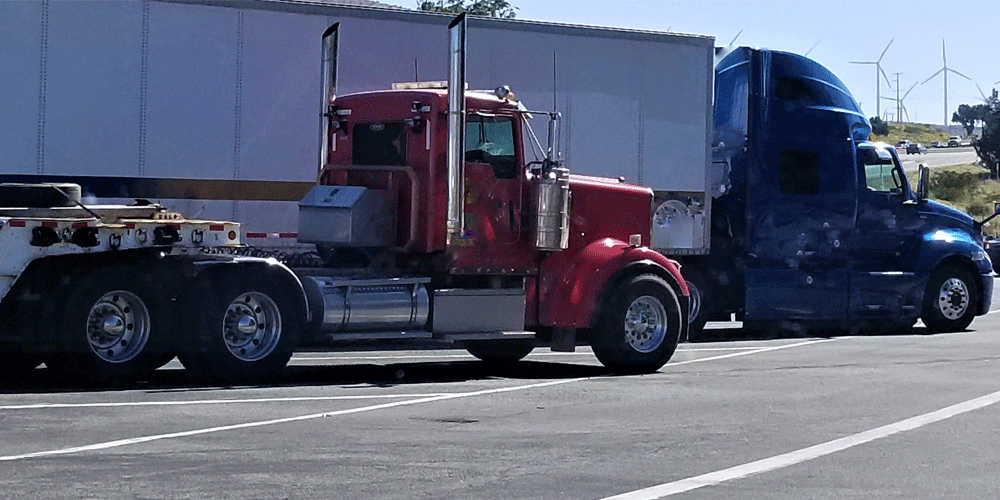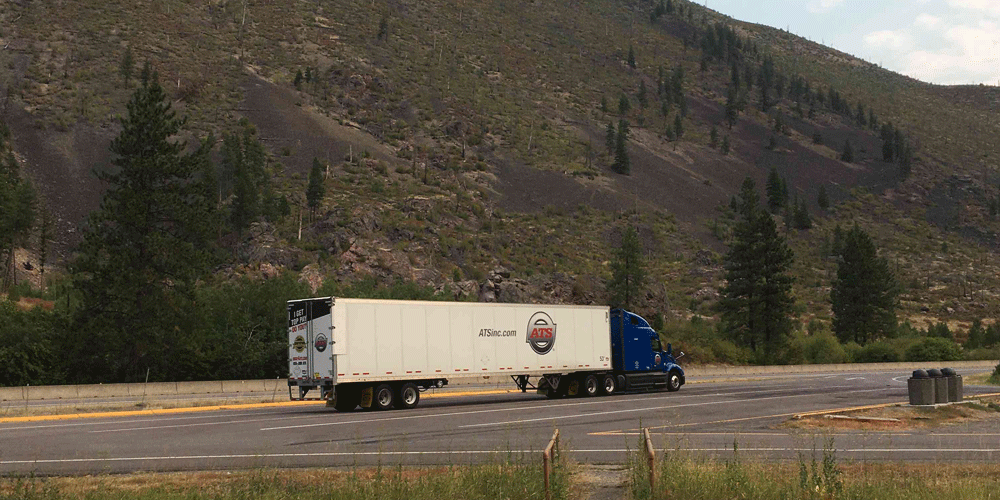Switching Trucking Jobs: Why You Must Turn in Your Truck Before Orientation
Having grown up around the trucking industry — with his dad and several uncles serving as truck drivers — it’s only natural Jeron found his way into the industry as well. Jeron joined ATS in 2018 as a member of the marketing team, where he grew his knowledge of the trucking industry substantially. Now as the driver recruiting manager, he is responsible for ensuring a smooth recruiting process in order to create a quality driver experience.
Let’s imagine a scenario in which I decide I no longer want to work at the company I’m currently employed with. I’ll start putting out feelers to my professional contacts, reviewing openings in the area and sending out my resume. Because I work in a corporate office, I might have to take a long lunch to go to interviews or I’ll take paid time off. I won’t quit my current position until I receive a job offer and start date at another company.
As a truck driver, the process for you works a lot differently. Yes, you’ll research trucking companies and talk to family and friends about different companies and you’ll be invited to attend driver orientation (the equivalent of several rounds of interviews). But you won’t be officially hired or offered an independent contractor agreement at the company until you go through orientation.
In the meantime, you have to quit your current carrier, turn in your truck and put your faith in the new company you’re going to, with the hopes everything will go smoothly and you’ll be able to work with the carrier.
For many drivers, that feels like a risky step. There’s not much of a safety net. What if something comes up in your record that puts you out of guidelines? What if you go to orientation and don’t like the company? You’re either stuck at a company you don’t like or you’re jobless.
To work through this, some drivers decide not to quit their current carrier until they go through orientation and get offered an opportunity with a new carrier. That means, for a time, they have two trucks.
However, this “solution” can get you into a lot of trouble with both carriers. In some cases, you can lose your spot on the fleet with both companies. You can even be slapped with a truck abandonment (leaving your truck in a random location rather than turning it in) — which will go on your driving record forever and will affect your chances of getting trucking opportunities in the future.
Together with our orientation team, I help oversee driver orientation at Anderson Trucking Service (ATS). We help drivers succeed in orientation to get them back on the road earning money.
In this article, I’ll be discussing the importance of turning your previous truck in before you get to new driver orientation, the consequences if you don’t and how you can give yourself a safety net as you transition from company to company.
Changing Jobs: Why Some Drivers Don’t Quit Their Old Jobs Right Away
Truck drivers carry risks when they leave trucking jobs to go to a new company. Just because you’re invited to orientation doesn’t mean you’ll end up getting an opportunity at that company. First, you have to meet guidelines, pass a drug test, pass the road test and get through orientation smoothly. You also have to decide if you like the company and still want to drive for them.
Some drivers may decide to leave orientation because they don’t like the new carrier. Maybe your expectations no longer align or you learned something in orientation that’s different from what you learned during the recruiting process.
On the other hand, if something comes up on your consumer reports or work verifications that puts you out of guidelines (too many jobs, a preventable accident, a truck abandonment, etc.), you can be sent home without a job. The company you just quit may take you back, but maybe not. It varies from carrier to carrier and situation to situation.
Related: What happens if I’m sent home from driver orientation?
To prevent this from happening, some drivers don’t actually quit their current trucking jobs until they’re certified at a new carrier. To keep their safety net, they simply go through the recruiting process at a new carrier and take home time or vacation time for the time they’ll be at new driver orientation. They don’t turn in their truck; instead, they may park it at home or somewhere safe.
Then, if they get certified to drive for the new carrier, they make a plan to return their old truck — whether that means they try to take home time right away with their new carrier or through some other means. Either way, they typically have a plan in the back of their mind to turn their old truck in.
If either carrier finds out a driver has done this, they can face negative consequences.
Consequences of Abandoning Your Truck
While carriers do understand you’re trying to protect yourself by keeping your old truck and not quitting your carrier, it can still result in a few different negative outcomes for you.
The best-case scenario is that your new company will let you turn your old truck in. However, you’ll most likely have to foot the bill to travel to wherever you left the truck, drive it to an approved drop-off location and pay to get back to your new company and truck. You’ll lose money covering traveling expenses and you’ll waste time moving a truck that isn’t providing you any revenue.
Side note: Did you know, on average, it costs a driver $1,000-$2,000 out of pocket to change jobs? Choosing to hang onto your old truck and return it later could easily double those costs for you.
It delays you from earning money right away with your new carrier, but it also doesn’t put forth a great first impression. In fact, it can come off as a big red flag. If you have any other red flags, you could be deemed as someone carriers don't want to work with.
Plus, if your other (current) carrier finds out, they may not keep you on their fleet either. You could be left jobless.
Even though you technically haven’t abandoned the truck yet, your current carrier could still consider it a truck abandonment. For instance, when you’re at orientation, the carrier will run work verifications. That’s typically when companies find out you haven’t turned your truck in yet. Up until then, they simply thought their driver was on home time.
So, while you may be simply trying to protect yourself, it can come back to bite you.
Why Carriers Don’t Like to Work With Drivers With Truck Abandonments
Truck abandonments are a bit of a controversial subject, and oftentimes drivers and carriers aren’t on the same page about it.
There are countless reasons why drivers abandon their trucks. For starters, they may simply be upset with their carrier and feel scorned about the way they were treated. To retaliate, they may leave their truck with the keys in it in the middle of a parking lot somewhere — where it’s at risk of theft and vandalism.
In other circumstances, a driver may not be getting paid on time or they’re being mistreated by the carrier, so they feel their only solution is to leave the truck and go elsewhere.
To the carrier, abandoning a truck is the ultimate no-no. It’s extremely inconvenient and expensive when drivers abandon trucks — especially if they’re under a load. They have to pay a driver to go recover the truck — a driver who otherwise would have been hauling freight for a customer. Drivers are charged for these fees but don’t often pay them (unless they’re sent to collections).
Not only is there the expense to recover the truck (and load, if applicable) but if the truck was towed from where it was abandoned, there can be hundreds or thousands of dollars in tow yard fees to pay before the asset can be released.
Abandoned trucks are vulnerable to theft and vandalism. Understandably, carriers don’t want their expensive assets destroyed. That’s why they have predetermined locations for drop-offs. From the carrier’s perspective, it reflects poorly on the driver if they abandon a truck.
Protect Yourself When Switching Trucking Jobs
Trucking companies understand you want to protect yourself, but working for two carriers as described above isn’t the best way to go about it. Instead, you can apply the following strategies to make sure you’ll be offered an opportunity and aren’t taking a huge risk going to a new company:
- Disclose your driving history
- Research the carrier (ask questions, talk to friends/family, read reviews, etc.)
- Look into backup carriers
The best way to avoid getting sent home from orientation for something on your driving record is to be upfront about it. When the recruiter tells you about guidelines, it’s in your best interest to either bow out if you know you don’t meet the requirements. One way or the other, carriers will learn about your driving history, so it’s best to be honest from the jump.
The second thing to do is to research the carrier thoroughly. You can do this in a few ways to ensure you’re getting the most accurate information possible. For starters, ask your recruiter questions from this list of 94 questions during your first conversation. The list might seem extensive, but it’ll help you determine what the carrier does and doesn’t have to offer you.
Remember, the recruiting process isn’t just about finding out if the carrier wants to work with you. It’s also about determining if the carrier meets your needs and can provide a satisfying path for you. If you don’t align, but you don’t find out until orientation, you may end up leaving without a job.
It’s also a good idea to talk to other drivers at the company, talk to friends and family who may have experience with the carrier and read reviews. The information should all align for the most part (though keep in mind, most people who write reviews are upset in some way).
Related: How to read trucking company reviews
Now, unfortunately, there are some shady truck driver recruiters in the industry. We at ATS certainly don’t condone that behavior, but we know it happens. They may just be trying to get drivers in the door.
So, sometimes, you can try every strategy mentioned above and it might not work. That’s why it’s a good idea to come up with some backup trucking companies you’re also interested in. That way, if it doesn’t work out at driver orientation, you have another option to pursue. Then you avoid the risk of potential termination or getting hit with a truck abandonment.
As long as you do the above, give notice of your quitting, turn in your truck and attend orientation, everything should be fine.
Excel at Driver Orientation
Transitioning from one trucking company to another can be a challenging and uncertain process. Unlike employees in corporate offices who can secure a new job offer before quitting their current position, truck drivers face a unique situation.
They must resign from their current carrier and turn in their truck before being officially offered an opportunity at a new company during orientation. This process poses risks, as there is no guarantee of getting an offer from the new carrier, leaving drivers with potential joblessness and financial strain.
While some drivers may be tempted to work for both carriers during the transition period to maintain a safety net, doing so can lead to severe consequences. Carriers generally frown upon this practice, considering it a breach of trust and commitment. It may lead to negative outcomes, such as additional expenses for travel and lost revenue, while also raising red flags about a driver's reliability and dedication.
To mitigate risks and ensure a smoother transition, truck drivers are advised to adopt alternative safety nets.
In the end, the key to a successful transition lies in giving proper notice, turning in the truck and attending orientation with the new carrier. By taking these steps and utilizing the mentioned safety nets, truck drivers can navigate the process more effectively, secure a new position and start their journey with a fresh perspective and greater peace of mind.
Check out these tips from a driver recruiter about how to have a great orientation experience.




